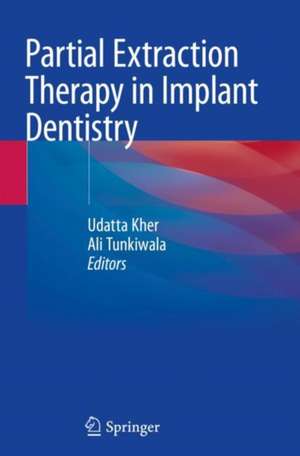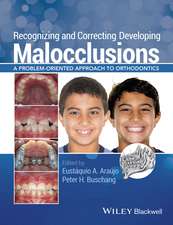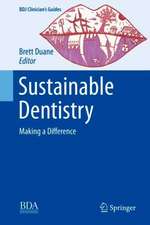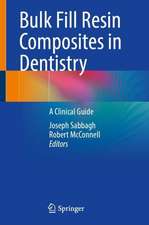Partial Extraction Therapy in Implant Dentistry
Editat de Udatta Kher, Ali Tunkiwalaen Limba Engleză Paperback – 3 ian 2021
| Toate formatele și edițiile | Preț | Express |
|---|---|---|
| Paperback (1) | 722.81 lei 38-44 zile | |
| Springer International Publishing – 3 ian 2021 | 722.81 lei 38-44 zile | |
| Hardback (1) | 995.59 lei 38-44 zile | |
| Springer International Publishing – 3 ian 2020 | 995.59 lei 38-44 zile |
Preț: 722.81 lei
Preț vechi: 760.85 lei
-5% Nou
Puncte Express: 1084
Preț estimativ în valută:
138.31€ • 144.40$ • 114.47£
138.31€ • 144.40$ • 114.47£
Carte tipărită la comandă
Livrare economică 01-07 aprilie
Preluare comenzi: 021 569.72.76
Specificații
ISBN-13: 9783030336127
ISBN-10: 3030336123
Pagini: 413
Ilustrații: XIII, 413 p. 838 illus., 756 illus. in color.
Dimensiuni: 155 x 235 mm
Ediția:1st ed. 2020
Editura: Springer International Publishing
Colecția Springer
Locul publicării:Cham, Switzerland
ISBN-10: 3030336123
Pagini: 413
Ilustrații: XIII, 413 p. 838 illus., 756 illus. in color.
Dimensiuni: 155 x 235 mm
Ediția:1st ed. 2020
Editura: Springer International Publishing
Colecția Springer
Locul publicării:Cham, Switzerland
Cuprins
Biological Rationale for Partial Extraction Therapy.- Surgical Technique of the Socket Shield Procedure: Step by Step Protocol.- Case Selection and Contraindications in PET.- Fabrication and Design of the Provisional Restoration.- Variations of the PET Procedure.- Socket Shield Technique for Multi-rooted Teeth.- Managing the Pontic Sites with PET.- Full Mouth Rehabilitation with PET.- Management of Complications and Failures in PET.- Current Evidence for PET.- Extending the Scope of PET and Future Trends.
Notă biografică
Udatta Kher, BDS, MDS maintains a private practice in Mumbai specializing in Implant Dentistry and Complete Oral Rehabilitation. He acquired a master’s degree in Oral Surgery from the Government Dental College, Mumbai in 1995. Dr. Kher has held an academic position as adjunct faculty in the Department of Implant Dentistry at the SDM Dental College, Dharwad. He has been head of the dental department at K.J. Somaiya Hospital and Research Center, Mumbai, and served as a consultant oral surgeon at the prestigious Breach Candy Hospital, Mumbai. He is the director of ‘Impart Education’, an academy for continuing dental education in India. Dr. Kher has authored numerous publications on implant dentistry in high-ranking peer-reviewed journals and, as an invited expert on the subject, has the unique distinction of addressing audiences in every continent across the globe. His presentations at major scientific meetings like the European Academy of Osseointergration, Euro-Perio andlectures at the Dental XP Global Symposiums in the U.S.A have been acclaimed. He is a registered ITI speaker having been a guest speaker on Partial Extraction Therapies (PET) at ITI study clubs in India, Italy, and Greece.
Ali Tunkiwala, BDS, MDS, is an implant dentist and prosthodontist maintaining a dental practice focusing on implants, aesthetics, and full mouth rehabilitation at Khar (West) in Mumbai, India, for the past 23 years. Dr. Tunkiwala graduated from Nair Hospital Dental College in 1996 and went on to gain his Masters’ degree in Prosthetic Dentistry from Mumbai University in 1998. He is an Accredited Member of the American Academy of Cosmetic Dentistry and a Fellow and Diplomate of the International Congress of Oral Implantologists and the Indian Society of Oral Implantologists. He is a speaker for the International Team for Implantology (ITI) and the Director of “Impart Education”, an academy for continuing education in implant dentistry that aims to guide clinicians towards predictable evidence-based dental practice. Dr. Tunkiwala serves on the editorial boards of various journals and periodicals in dentistry. He has authored a number of peer-reviewed journal publications and a chapter in the book titled "Graftless solutions in Implant Dentistry". He lectures globally on the topics of implants, aesthetic dentistry and full mouth rehabilitation.
Ali Tunkiwala, BDS, MDS, is an implant dentist and prosthodontist maintaining a dental practice focusing on implants, aesthetics, and full mouth rehabilitation at Khar (West) in Mumbai, India, for the past 23 years. Dr. Tunkiwala graduated from Nair Hospital Dental College in 1996 and went on to gain his Masters’ degree in Prosthetic Dentistry from Mumbai University in 1998. He is an Accredited Member of the American Academy of Cosmetic Dentistry and a Fellow and Diplomate of the International Congress of Oral Implantologists and the Indian Society of Oral Implantologists. He is a speaker for the International Team for Implantology (ITI) and the Director of “Impart Education”, an academy for continuing education in implant dentistry that aims to guide clinicians towards predictable evidence-based dental practice. Dr. Tunkiwala serves on the editorial boards of various journals and periodicals in dentistry. He has authored a number of peer-reviewed journal publications and a chapter in the book titled "Graftless solutions in Implant Dentistry". He lectures globally on the topics of implants, aesthetic dentistry and full mouth rehabilitation.
Textul de pe ultima copertă
This book covers all clinical aspects of partial extraction therapy (PET), a revolutionary technique that offers long-term stability of soft and hard tissue around implants. Readers will find step-by-step protocols, valuable insights, and helpful tips, backed by the best available scientific evidence. After explanation of the biological rationale for PET, the socket shield technique, which entails partial extraction of the tooth root prior to implant placement, is clearly described and illustrated. Guidance is then provided on case selection, contraindications, and fabrication and design of the provisional restoration. Variations in the PET procedure are explained, and techniques presented for the management of multirooted teeth, pontic sites, and full mouth rehabilitation. Advice is also offered on how to deal with complications and treatment failures. Finally, the current evidence for PET and the scope for extending its use are reviewed. PET has gained immense popularity in recent years, and this book will be of value for clinicians, students, and academicians.
Caracteristici
First book devoted to partial extraction therapy Clear description and illustration of technique Guidance on case selection, complications, and failures














